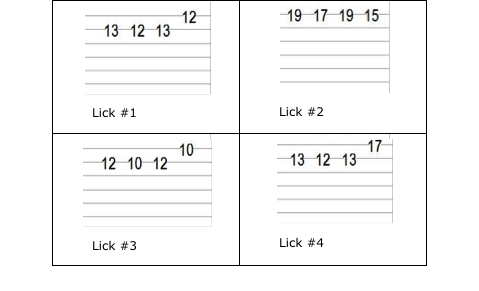It's great to be able to use only one pitch to make your playing feel more emotional... but to make your guitar solos overflow with emotion, you need to squeeze as much feeling as possible out of every note in every guitar lick.
Notice: To fully understand the ideas in this article, it's crucial for you to read the third part of this series about playing highly emotional guitar solos.
To increase the emotional intensity in every single lick of your solos, you have to become aware of how each note feels as it is played above a specific chord/chord progression. Every note you use in your solos has a different function while it is played over different chords, so you can change the way a lick feels emotionally by combining different notes together. For instance, if you are using the notes G, A flat, and D flat over an F minor chord, every note will have a unique function (G = second, A flat = third and D flat = sixth). If you replace the D flat note with an F note (the root), the F note will function differently and completely alter the way the lick feels as a whole.
Visualize painting a picture using different colors. As you use one note over a chord, you only experience a certain emotion (this is the function of that note). Then as you combine this note together with several others, it's like blending many colors together to create a new one. You are already familiar with the idea that changing a few notes in a small lick will produce an entirely new emotional feeling... now you understand why this occurs.
To hear precisely what this sounds like, watch the video below:
To begin implementing this idea into the licks of your guitar solos, play the .mp3 samples below and use the instructions I made for you. Keep in mind that each sample has been recorded for an entire minute in order to make it easier to complete the steps below:

Lick 1 - Hear it
Lick 2 - Hear it
Lick 3 - Hear it
Lick 4 - Hear it
Step 1 - Listen to the first sample lick and play this chord progression above it:
G major - E minor - A minor - C major
(Play each chord several times to give yourself enough time to understand the emotion created by each note.)
Step 2 - Think about how each note in the lick is functioning over the chords you played. This is crucial for helping you understand WHY a specific lick feels the way that it does. By knowing the specific function of each note (over a specific chord), you can recreate the same feeling of that note in other soloing scenarios. This is massively more beneficial to know as a musician than merely knowing that "Lick X sounds cool when its played over Chord Y".
If you need to improve your music theory understanding to better follow the previous step, watch this video about music theory.
Step 3 - Go back and repeat the first two steps. This time, play the chord progression in step one over the other three audio samples.
Step 4 - Go back and repeat the first two steps again. Instead of using the chord progression from step one, play these chord progressions over the licks they specify from above:
Play over guitar lick two: G major - F major - A major - E major
Play over guitar lick three: C major - G major - A minor - F major
Play over guitar lick two: C major - E minor - C major - G minor
Once you have finished the steps above, it will be much easier for you to understand how each note you play changes the overall feeling of your guitar licks. It's crucial that you continue to pay close attention to the notes you use in your solos, so you can always convey the particular emotions you want - instead of mindlessly playing a bunch of memorized licks/patterns and waiting for something to sound good (like a lot of guitar players do).
It will become second nature for you to get maximum expression in your guitar solos, when you use the idea above with embellishments and cool phrasing nuances that turn boring guitar licks into badass guitar licks).
When you have the power to make any note sound incredibly expressive and can control the emotions of each note over specific chords, your guitar solos will become like an extension of your soul - making your playing sound highly creative and unique.
To learn even more ways to play highly emotional, self-expressive guitar solos, read this page on how to create strong emotions in music.
Tom Hess is a professional touring guitarist and recording artist. He teaches, trains and mentors musicians from around the world.
Visit his site to discover highly effective music learning resources, guitar lessons, music career mentoring and tools including free online assessments, surveys, mini courses and more.